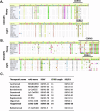Broadly potent spike-specific human monoclonal antibodies inhibit SARS-CoV-2 Omicron sub-lineages
- PMID: 39354108
- PMCID: PMC11445456
- DOI: 10.1038/s42003-024-06951-7
Broadly potent spike-specific human monoclonal antibodies inhibit SARS-CoV-2 Omicron sub-lineages
Abstract
The continuous emergence of SARS-CoV-2 variants of concern has rendered many therapeutic monoclonal antibodies (mAbs) ineffective. To date, there are no clinically authorized therapeutic antibodies effective against the recently circulating Omicron sub-lineages BA.2.86 and JN.1. Here, we report the isolation of broad and potent neutralizing human mAbs (HuMabs) from a healthcare worker infected with SARS-CoV-2 early in the pandemic. These include a genetically unique HuMab, named K501SP6, which can neutralize different Omicron sub-lineages, including BQ.1, XBB.1, BA.2.86 and JN.1, by targeting a highly conserved epitope on the N terminal domain, as well as an RBD-specific HuMab (K501SP3) with high potency towards earlier circulating variants that was escaped by the more recent Omicron sub-lineages through spike F486 and E484 substitutions. Characterizing SARS-CoV-2 spike-specific HuMabs, including broadly reactive non-RBD-specific HuMabs, can give insight into the immune mechanisms involved in neutralization and immune evasion, which can be a valuable addition to already existing SARS-CoV-2 therapies.
© 2024. The Author(s).
Conflict of interest statement
The authors declare no competing interests.
Figures






References
-
- WHO. WHO Coronavirus (COVID-19) Dashboard https://covid19.who.int/2022
-
- WHO. Global excess deaths associated with COVID-19, January 2020 - December 2021. who.int; 2022 May 2022.
-
- WHO. Tracking SARS-CoV-2 variants https://www.who.int/activities/tracking-SARS-CoV-2-variants2022.
-
- Wibmer, C. K. et al. SARS-CoV-2 501Y.V2 escapes neutralization by South African COVID-19 donor plasma. Nat. Med27, 622–625 (2021). - PubMed
MeSH terms
Substances
Supplementary concepts
Grants and funding
LinkOut - more resources
Full Text Sources
Medical
Miscellaneous

